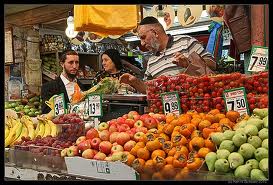As the bright Mediterranean sun streams in from our window, we crunch down on fresh bread from the Mahane Yehuda market in Jerusalem. The crust is thin and crackly, the inside soft and moist. We were at the market late last night, near closing time. It capped a day spent walking the paving stones of the Old City.
We were at the market late last night, near closing time. It capped a day spent walking the paving stones of the Old City.
We were in the “new city” where the new buildings predates the voyages of Columbus, Magellan, and Vasco da Gama. Armed with our electronic “parking pass” we applied New York City skills to find an open curb to park our car: wait for someone to leave, and stop all traffic if you must to secure your rightful place.
Armed with my iPhone we cut across the alleys to get to the Mahane Yehuda market, perhaps the most colorful and visited market in Jerusalem. In our search for local food, local produce and local flavor, we had found our destination. Sabras (desert cactus fruit), mini-pineapples, fresh oranges (for juice), mangos at the peak of ripeness, sun-cured black olives, fresh feta cheese, and, of course, vine-ripe tomatoes. I once learned that they grow tomatoes in the desert and feed them salt water (from the dead sea) to increase their sweetness. When eating tomatoes in Israel, you can appreciate that tomato is a fruit, and not a vegetable for the juice is so sweet.
Don’t ever go to a market hungry. If you do you will emerge burdened with copious amounts of food. Luckily we were both tired and hungry. We secured a modest amount of food. Though we did score an enormous chicken and a carton of 30 farm fresh eggs. The route out of the market led past Meir Sharim. We were for a while back in Eastern Europe. It could have been Warsaw before the Nazis, or Lodsk or Minsk. We emerged onto a broad avenue leading to Highway 1. Before we knew it, we saw the skyscrapers of Tel Aviv. And it was another night on Rotshchild Boulevard. Hundreds of youths were dancing in the street to the tunes of Bob Marley, sung in Hebrew by a live band.
